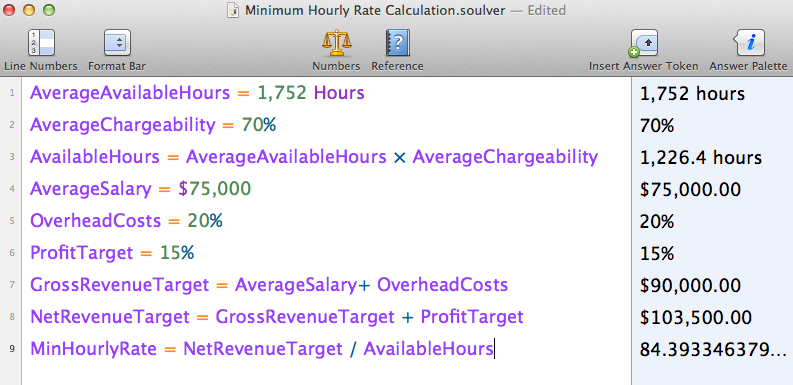How to calculate your hourly rate
Sometimes I get contacted by individuals who are planning to start a services company and are seeking advice on a variety of related topics. One of the most common questions is, “How do I determine an hourly rate?”
This article describes how we determine our rates here at Makalu.
Start with the minimum
Regardless of how you plan to charge for your work—i.e. on a project basis (fixed-fee) or an hourly basis—the first step is to determine the minimum amount you need to earn per chargeable hour.
-
Available hours. Begin by computing the number of hours per year each of our staff will work, on average, taking into account public holidays (12 days, in Germany), vacation (30 days, in Germany) and weekends (104 days, on Earth). In Germany, that’s 219 working days per year, or 1,752 available working hours.
-
Chargeable hours. It’s important to recognize that not all of a person’s available time will end up being chargeable. People will sometimes be supporting bids, sometimes working on overestimated projects, sometimes idle, sometimes off sick, etc. In our case, we assumed a chargeability figure of about 70% (which turns out to be pretty consistent with the service industry as a whole). With that, we’re down to about 1,226 chargeable hours per year, per person.
-
Minimal hourly rate. To compute a minimum hourly rate, we need to divide the minimum revenue we need to make per person, by those 1,226 chargeable hours. The total minimum revenue equals our employment costs (salary, benefits, social security, etc.), all overhead expenses (office rent, support staff, marketing, accounting, legal, etc.), plus the minimum profit we want to make.
Example. In a hypothetical scenario in which a company’s staff costs, on average, $75,000 per year per person, with overheads equivalent to say 20% of employment costs, and wanting to make a 15% profit, the minimum hourly rate would be roughly $85/hour.
How did we get to that number?

(If you’d like a copy of this Soulver document, you can download it here)
That wasn’t the particular number in Makalu’s case back when we got started, but might seem a reasonable starting point today.
Adjusting to balance supply and demand
Now that we have a starting point, is that it? Not quite. We now need to adjust that rate to balance supply and demand.
Over time, as we produced good work for our customers (and through some lucky breaks!), we found ourselves with consistently more demands on our time than we had availability. It’s important to note, however, that doesn’t necessarily imply a higher level of chargeability as all the elements relating to that 70% are usually still applicable.
As is natural in free markets, prices adjust in order to balance supply and demand, and so we began to slowly increase our hourly rate, in order to alleviate the excess demand. Some companies would have just ramped up their staff count. In Makalu, however, we place far greater importance on maintaining our ability to produce great work and deliver measurable value, and that means only hiring great people. We simply couldn’t find legions of great people; we’ve been lucky to find one per year!
An interesting consequence of increasing our hourly rate, is that the customers that were left tended to be exactly the type of customers we’ve always wanted to work for—they appreciate high quality, demand real value and are doing interesting things!

